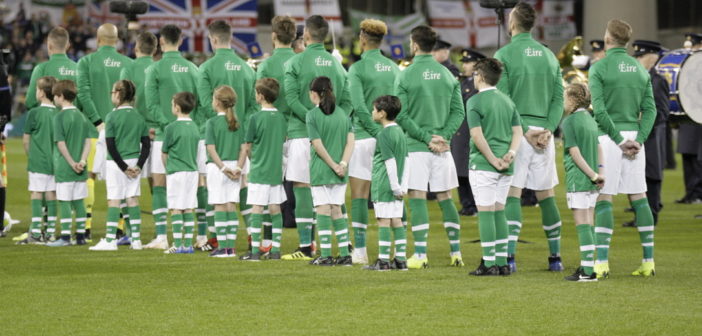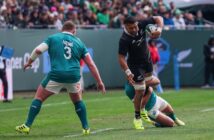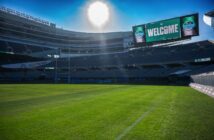“The relationship between the two associations is in a great place, and we want to celebrate that tonight,” said the pitchside announcer at the Aviva Stadium, Dublin, as two supporters ceremonially exchanged shirts pitchside ahead of the Republic of Ireland and Northern Ireland’s friendly on Thursday night in Dublin.
It’s not entirely true, though, that the relationship between the Republic’s FAI and the North’s IFA is ‘good’.
It was only earlier this year, for example, that Northern boss Michael O’Neill accused his compatriot Martin O’Neill of trying to secure players from Northern Ireland especially targeting those with Catholic roots. Nevertheless, until the Irish birder became one of the epicentres of the Brexit saga recently, there was no question that the political tensions in this part of the world were abating.
Even the existence of Northern Ireland, of course, has long been a source of dispute. When Ireland achieved its independence from the UK, a partition was drawn across the island. Northern Ireland was composed of six counties of Ulster and had a solidly pro-British and Protestant majority. That left the Irish Republic with 26 counties and a heavily Catholic majority, almost all of whom supported Home Rule and the independence.
Still, some of those in the south did not accept the division of their country, and an Irish Civil War ensued between the new Irish Government of the south and dissidents. The Government won and the border stayed not that the dissidents had any real chance of militarily defeating the Irish Government, then the Northern Irish state and then the British Army, merely to force 1 million people into a new Irish state against their will.
That settlement however left half a million Catholics who had yearned for a free Irish state still stuck in the UK, as a minority in Northern Ireland. They faced discrimination in jobs and housing. Political boundaries were gerrymandered to suit Protestant majorities.
A non-violent Civil Rights movement emerged and was brutally suppressed by the Northern Irish Police. TV photos of them battering unarmed demonstrators perturbed politicians in London. Eventually, the UK sent in troops to defend the Catholic population from both their Protestant neighbors and the police.
However seeing the British Army as the defenders of the Catholic population seriously irked militant Irish nationalists. To them, the British state as mush as their Ulster neighbours was the source of Ireland’s problems. Armed and dangerous, they made life difficult for the Army in Catholic areas and even worse for local people who were decent to the soldiers, eventually murdering their own people just to dissuade them from being civil to the British soldiers.
it worked and the British Army soon found themselves unwelcome and unwanted in Catholic areas. They also had very little idea how to peace keep and their inability to replace a biased and sectarian police force came to a head when the Parachute Regiment shot dead 14 peaceful Civil Rights protesters in Derry in 1972. The day became known as ‘Bloody Sunday’

20,000 people demonstrated in Dublin against IRA terror, at the time one of Ireland’s largest ever political demonstrations
A 30 year campaign of terrorist atrocities then engulfed Northern Ireland with groups of thugs hiding behind both Union Jacks and Irish Tricolours committing appalling atrocities against both the police and the civilian population. IRA terrorists killed nine people in one day later that year on what became known as ‘Bloody Friday’ and Loyalist pro-British terrorists killed 33 civilians in the Irish Republic in one day in 1974.
Some of the acts were so barbaric that people in Ireland showed widespread revulsion. After the Provisional IRA murdered two toddlers in the English town of Warrington, large demonstrations against their barbarity took place in Dublin, where 20,000 Irishmen and women gathered to voice their opposition to IRA terror.
After the loss of over 3000 lives and a desire to somehow end the uncontrolled spiraling of sectarian killing, terror groups on both sides laid down their weapons as a peace agreement was reached with the signing of the Good Friday Agreement in December 1999.
These days, there’s an open border between the two countries, and an agreement in place that gives citizens of the six counties in the north the right to choose their nationality: British, Irish, or – if they so wish – both.
More often than not, Republicans from Northern Ireland support the Republic of Ireland national team, as the Northern Ireland team is, traditionally, seen as a Unionist (as in Union with Britain) entity. In fact, many more ardent Republicans don’t recognise the North’s right to exist at all.
It probably comes as no surprise to anyone that this spills over into football.
The Republic view Northern Ireland’s use of ‘God Save The Queen’ as their national anthem, for example. as antagonistic (in Dublin, they boo it relentlessly).
Northern Ireland take issue, particularly, with the Republic’s midfielder James McClean, whose refusal to wear a poppy commemorating Britain’s World War I war dead when he plays for English club side Stoke City has become an annual talking point. It doesn’t help that he is Northern Irish and deiced to play for the Republic and was doing so against his own country last night.
In the away ended, draped in banners depicting the red hands of Ulster, and British union flags, McClean’s every touch was booed, but the energetic player has his reasons. Born in the North’s second city – known as Derry or Londonderry, depending on which side you ask – McClean sees the British army as a symbol of his early-life oppression, and will not wear their symbol, however well intended it might be.
The home fans found a player to target too. Kyle Lafferty plays for the traditionally Protestant club Rangers in Glasgow,. He was similarly a target of the home fans, some of whom display their love of Ireland by supporting another Scottish club Celtic which was funded by Irish immigrants in Glasgow.

A fan brought the flag of the Parachute Regiment, responsible for Bloody Sunday, to Dublin
Photo: Irish Mirror
There’s a further anachronism on this particular day, too.
Brexit negotiations are in full force in British parliament, and one possible outcome would involve the closing of the currently unmanned border between the Republic and Northern Ireland, a clever political quirk that allows both sides to claim a certain amount success in terms of access to what they see as their identity.
The whole clever balancing act is in danger of coming down.
It’s unfortunate timing for the match, falling on perhaps the most politically delicate day in recent British history, and inevitably there are fall outs.
The two fans seems to be mixing well in the pubs in east Dublin ahead of the game, and the booing of players and anthems had a pantomime feel to it rather than any genuine viciousness. As is the wont of a certain breed of European soccer fans, though, another level emerges after the game.
The two sides draw 0-0, and the game is insipid, but perhaps it’s the best result from a ‘keeping the peace’ point of view. But it turns out a Northern Ireland fan has unveiled a flag of the aforementioned British parachute regiment with some dubious Irish history. Later, two Northern Ireland fans were beaten up in the city, and local police enforced a ‘ring of steel’ separating fans of the two teams.
The younger generation on both sides of the border seem increasingly sick of the island’s polarisation, a clear and shining positive impact of the 1999 deal. When it comes to football, though, the bitterness is palpable.
Only 31,000 show up at the Aviva, the Republic of Ireland’s lowest home attendance in quite some time. It’s easy to see why. We have to ask ourselves, is this particular match up a good idea? Or would this exercise in dubious relationship building be best left well alone?
![Prost International [PINT]](https://prostinternational.com/wp-content/uploads/2021/08/PINTtFontLogoRoboto1536x78.jpg)



